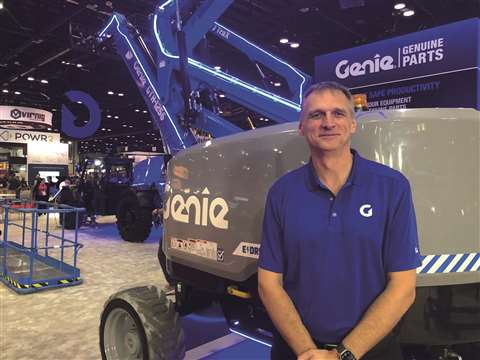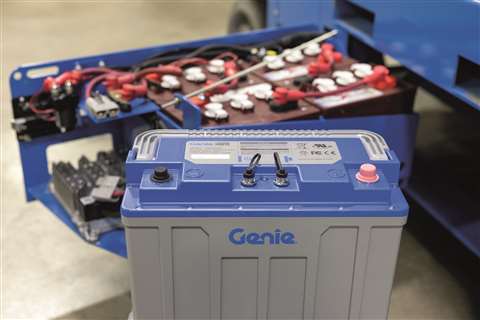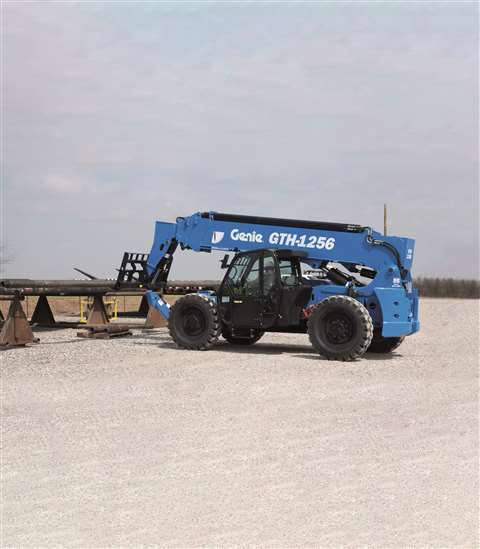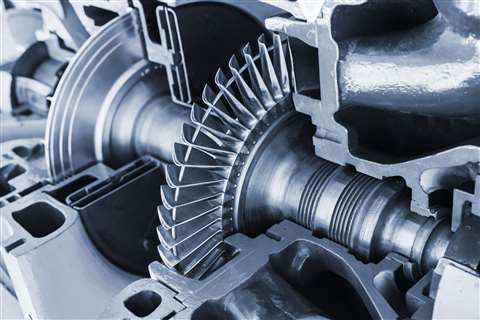Genie president reveals truth behind operational changes
13 April 2023
Genie president Simon Meester presents his view of the access industry and challenges its facing, following major recent news at the company.
Genie’s president of just over 18 months Simon Meester came into the role while the side-effects of Covid on the industry were just getting started. Now that the industry is starting to get back on an even keel, he shares his view of how the company and the access sector now stands.
Meester took over the position of president in August 2021 from longstanding president Matt Fearon. Prior to that he had been the company’s chief operating officer, having joined Genie in 2018, following a stint as vice president and general manager at Eaton Corporation’s Industrial Control Division. Previously, he held senior roles at Caterpillar and Sandvik.
Now Meester is presiding over significant change at Genie as a result of a range of challenges, experienced across the industry, such as the effects of covid in the form of supply chain constraints and the shortening of labour supply.
 Simon Meester, President at Genie. (PHOTO: Genie)
Simon Meester, President at Genie. (PHOTO: Genie)
Manufacturing moves to Mexico
One area of change is in manufacturing footprint, with 10 of Genie’s production lines moving to its new facility in Monterrey, Mexico later this year. It follows the announcement last year that the company would close its Oklahoma facility and shift its telehandler production to Mexico.
The Monterrey plant has been under construction for nearly two years and is set to officially open early in the second quarter.
Product lines to be shifted include a range of the company’s scissor lifts that are currently being produced in China, as well as some of Genie’s vertical mast lifts from its Redmond, Washington facility. Additionally, all telehandlers will eventually be manufactured at the Monterrey plant too.
One of the issues facing the company is that in the Northwest of the US, where its head office was based in Washington state, is the shortage of labour. Meester says, “We can’t find enough labour so we are rightsizing our facilities, mostly at Redmond, where it would give us the right size of production so we can fill the capacities of the lines with the required labour.”
Last November the Genie headquarters relocated from Redmond to Bothell, only about 20 minutes away. The move to Bothell affected office space specifically, while manufacturing facilities remain in Redmond.
Meester explains, “During covid the book was re-written on what the office was, and we felt that we wanted a space that was more in line with a home office, of sorts. So, we built a collaborative space that we are super proud of.”
The decision to move office space out of Redmond was also driven by the increasingly international structure of the company. “We are becoming much more global every year. We asked ourselves, ‘do we need this much space?’.
“[The answer is] we really don’t, combined with those that want to work from home. Although our policy is to work in the office, we do want to be a modern company and where it makes sense to allow people to have that option we provide it.”
Made in Mexico Vs Made in China
While Genie is also moving production lines from its factory in China, the facility will continue play an important part in the company’s future, insists Meester. “We are a global player and will always continue to pursue business globally, we are not changing that.”
 The Lithium-Ion battery option is available globally on nearly all GS E-Drive slab scissor lifts, with the exception of the GS-1432m and GS-1932m micro scissor lifts and the GS-4046 and GS-4655 slab scissor lifts. (PHOTO: Genie)
The Lithium-Ion battery option is available globally on nearly all GS E-Drive slab scissor lifts, with the exception of the GS-1432m and GS-1932m micro scissor lifts and the GS-4046 and GS-4655 slab scissor lifts. (PHOTO: Genie)
The recent zero-Covid policy in China, resulted in a swathe of dramatic lockdowns, which were then lifted towards the end of last year, leading to Covid spreading quickly, including through the Genie team. “At one point we had 40% to 50% of our team members in the same week struck by Covid so we ran for one day to the next with half the people.”
Once the factory was back in full swing, Meester says, “They were able to recover in a month whatever we had lost, so the resilience of the team was spectacular.
“That team will always be part of the Genie future. We have that global flexibility - we can play with our footprint based on what the dynamics are.”
As in the past, the China plant will produce for its domestic market China, and it will also produce products for export. “There’s not a line in the sand as things constantly change, so we leverage our footprint to whatever we think is the best.
“We feel fortunate to have a footprint that is adaptable to whatever the world throws at us.”
Biden’s infrastructure bill
The infrastructure Bill introduced in the US by Joe Biden in November 2021 has seen thousands of projects awarded funding across the country. However, a vast majority of those projects are yet to begin, meaning the effects of the funding will not be felt for some time.
Meester explains that while some of the allocated projects are getting started the rush is yet to occur.
“We don’t see a real big wave just yet. We see that taking off towards the end of 2023 early 2024.” An example of one of the first movers, says Meester, is Intel, which is already building two factories but the “big wave” is likely to follow towards the end of the year.
It will, adds Meester, give the US a good run for the next couple of years, combined with the fact that the country is sheltered from some of the storms that Western Europe is experiencing, for example its proximity to Ukraine.
Despite the issues, Meester is a firm believer that free markets will balance out eventually. “We probably go a little too far, then we come back again but eventually we will always come back. Today we are still constrained - we still have way too many parts arriving at our assembly lines late or sometimes not at all, often on a weekly basis.”
Supply chain planning
Expanding on the supply chain, he adds, “There is still a lot of disruption; a lot of chaos. Things are nowhere near where we want them to be.
“We do see it slowly improving,” Meester adds, “Just not fast enough.”
Therefore, 2023 will continue to be a story of constrained supplies. “We now need to make sure we stay close to our customers. As they have aged their fleets. We need to a make sure we work with them and start aligning what we can supply against what they need and make sure we get the industry back to targeted fleet age levels as soon as possible – that is the name of the game at the moment.”
Following a significant amount of merger and acquisition activity in the US in the rental sector over recent years, does Meester believe that the same will happen on the OEM side?
“I think it will probably ramp up – for the last three to five years the multiples were really not there so it’s mostly been private equity but as the multiples become more reasonable I think M&A activity will start to pick up. “
Returning to the top of Europe, the Middle East, Russia and India (EAMEARI) region has a new vice president of sales and support. Will Westley was promoted from his UK and Ireland role, and replaces Jacco de Kluijver, who has moved to the position of vice president of business development in the EMEARI.
European equipment market outlook
However, beyond these role allocations, there are no plans for wider organisational change in Europe. “We are very happy with the way we are operating,” says Meester. “The only feedback we have is for more product and fast.”
On market conditions, Meester is more cautious. “Economy wise, I’m a little bit more worried about Europe than I am for North America.
“While this mostly relates to challenges caused by the war in Ukraine, there is a little less stimulus going into that economy than there is in North America.”
Whichever way you look at it, says Meester, “It’s a rollercoaster but if I was a betting man I would say Europe might be in a slightly tougher spot, simply because of their proximity to the Ukraine conflict than anyone else.”
Stepping back into the realms of new products, one of the big conversations is around those fuelled by new energy options.
Hybrid and electric access equipment
Ever since the question over pure electric versus hybrid arose for RT booms, Genie has stuck to its guns, opting for the hybrid option with its FE range. The company does of course provide electric machines too, but it sees its true hybrid FE as the realistic option.
“We go by the case of what makes the best return for customers in terms of TCO. Technically, we can electrify anything immediately but it doesn’t necessarily make sense to our customers.
“Just because we can, doesn’t mean we should. That’s why we believe the best way to go is hybrid on our booms and on scissors it’s the electric lithium drive because its the right technology for the right time.
“We could go all in on full electric right now? But we don’t think that’s what our customers want right now, and our order book is saying just that because the FE is selling like cup capes.”
On the other hand, Meester continues, some markets will have different requirement from others, “It’s really important to understand we strongly believe that you cannot assume that the whole world is looking at this the same way.
Regional market demand
For example, in central London, UK, an electric boom would often be the product of choice, as on a typical jobsite in China where the site is hooked up to the utility grid as a first step as a project gets underway.”
In contrast. “If you look at North America there a lot of remote worksites with no infrastructure available. To give them a full electric boom would not make any sense.”
As Meester says, this is where the true hybrid FE comes into its own. If you took the combustion engine out it would be a 100% electric boom lift.
Ultimately, there will be a drift towards the use of alternative fuels for most equipment, telehandlers included.
And Meester believes that smaller units would tend to be run using lithium batteries while larger units would go down the road of hydrogen-powered equipment.
And there is another reason to spread your interests. “If you offer everything with lithium, then suddenly the price of lithium goes through the roof, you’re stuck.”
 Genie GTH-1256 telehandler. (PHOTO: Genie)
Genie GTH-1256 telehandler. (PHOTO: Genie)
Major telehandler launch
Larger telehandlers are a trend across the industry. The latest from Genie, which made its debut at the ARA Show, in Florida in February, is the 5,450kg (12,000lb) maximum capacity machine, for the North American market.
It can handle loads of 2,721kg (6,000lb) at its full 17.1m (56ft 3in) height and 1,599kg (3,500lb) at its maximum 12.8m (42ft) reach.
Designed to offer a lower total cost of ownership, the GTH-1256 is the sister model to the GTH-636, GTH-844 and GTH-1056 machines.
Broadening out on the question of what the future is for telehandlers driven using alternative power sources. Genie’s Simon Meester is cautious on the matter.
“We don’t think a full electric telehandler makes sense at this minute. We think at some point a hybrid telehandler makes more sense but it will need to be at the right time.”
“Again, we can do it today, but do you want a GTH-5519 (2,495 kg capacity) that only drives at 5mph. Our customers tell us that’s not what they are looking for - they want a machine that can run full throttle, heavy duty all the time, without having to worry about recharge.”
STAY CONNECTED



Receive the information you need when you need it through our world-leading magazines, newsletters and daily briefings.
CONNECT WITH THE TEAM









